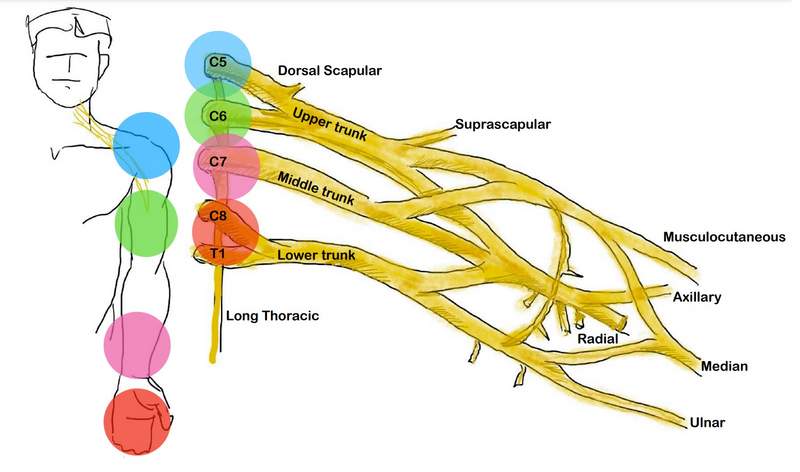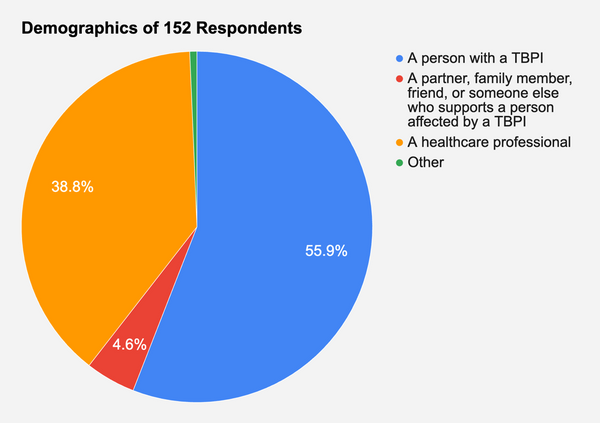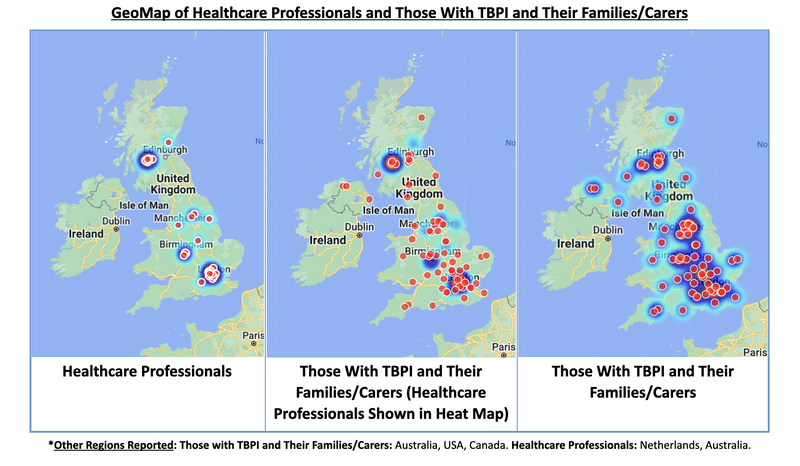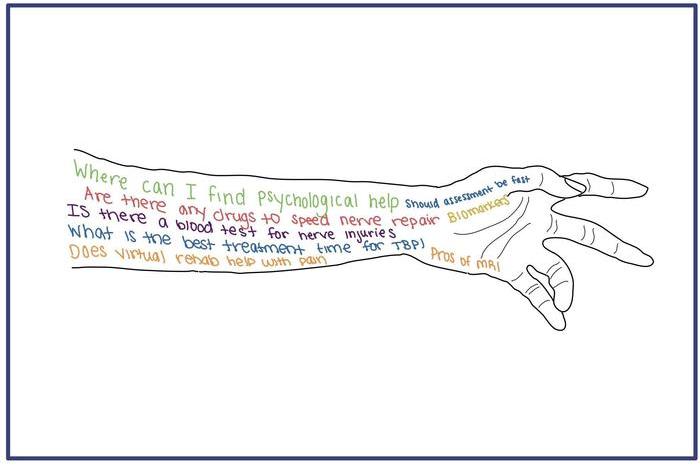Establishing the top 10 priorities for future research in traumatic brachial plexus injuries – A James Lind Alliance Priority Setting Partnership
By Kunaal Motrejaa, Matthew Wilcoxb, Tom Quickb,c and Hazel Brownb,c
aDes Moines University Medical School, Iowa, USA
bCentre for Nerve Engineering, University College London, UK
cPeripheral Nerve Injury Unit, Royal National Orthopaedic Hospital, UK
We would like to thank and acknowledge the contribution of the TBPI JLA steering group (Steve Bloyce, Grainne Bourke, Dean Boyce, Phill Burke, Neil Finney, Dennis Hazell, Tim Hems, Louis James, Kate Kennard, Erika Kennington, Paul Malone, Caroline Miller, Gail Morrison, Suzanne Oxhey, Jude Roberts, Mandy Sinforiani, Ken De Zoyza), the TBPI-UK, RNOH Charity and all the partners, contributors and participants of Round 1 of the PSP.
Adult traumatic brachial plexus injuries (TBPI) are a cause of great and long lasting morbidity; affecting many thousands of people in the UK each year. These injuries have a great impact on the individual's ability to work, their family and social life. TBPI are also recognised to be associated with psychological distress and depression. Whilst there has been a great deal of research in this area, the focus has been mainly empirical, with fewer studies focussing on the aspects of the lived-experience that patients find challenging.

In order to advance future research and improve the care of patients in a coordinated and focused manner, it is important that basic science and clinical research are informed and driven by what is considered important by those who are affected by the condition. A methodology has been created to co-produce research priorities and bring together health-care professionals, families and those individuals who have suffered a particular health condition. The James Lind Alliance Priority Setting Partnership model has been implemented in order to direct the focus of research in many areas of clinical care (e.g. spinal cord injury, revision knee replacement, foot and ankle surgery, physiotherapy).
We have undertaken this process in our speciality area of TBPI and wish to share our experience and progress to date. This bulletin is also a request for further support and engagement from the British orthopaedic community to participate in the second round of the survey, and to consider adopting this process as an effective research tool in other speciality conditions.
What is a James Lind Alliance Priority Setting Partnership?
The James Lind Alliance (JLA) is a non-profit making institution, funded by the National Institute of Health and Care Research (NIHR). It oversees a rigorous academic process which unites clinicians, patients and their families and carers to form Priority Setting Partnerships (PSP) in order to identify the most important questions for future research in a particular healthcare issue.
The PSP is overseen by a JLA advisor and is comprised of a Steering Group (a collaborative group of healthcare specialists and patient partners). It is the responsibility of the steering group to develop surveys which are disseminated to the public for them to input their research questions with regards to the specific subject being addressed. The Steering Group meets regularly to assess the study’s progress. After gathering research questions via an initial survey, an Information Specialist themes and codes the responses to formulate summary questions which are then fed forward into the next round. The second survey requests the respondents to rate each of the summary questions which are contained within the survey in order to begin the prioritisation process. Once the second survey is complete, a final meeting of stakeholders (patients, carers, related charities and expert healthcare professionals) focuses discussion around the prioritised questions. The formation of a Top 10 list that identifies the most important unanswered questions concludes the process and the results are publicised to guide future research funding/efforts.

Adult Traumatic Brachial Plexus Injuries PSP
Our TBPI JLA Steering Group is chaired by our JLA advisor - Nahid Ahmad. Hazel Brown and Tom Quick are the Project Leads and they work with the Steering Group which is comprised of 17 experts in TBPI (patients, representatives from the TBPI-group, surgeons, therapists and nurses from London, Birmingham, Leeds, Glasgow, Swansea nerve injury units). The group has met every few months since the project inception in September 2022. The role of the steering group is to decide on the timeline, scope and content of the survey. Once these were agreed, the initial survey was developed and ready to be deployed.

The PSP information is available on the PSP website.
Survey - Round one
Round 1 of our survey was disseminated online in March 2023 and closed in June 2023. In this time period, over 700 questions were collated from 152 respondents. Of these 152 individuals, 85 (55.9%) were people with TBPI, 59 (38.8%) were healthcare professionals, and 7 (4.6%) were partners/family members/friends or carers of individuals affected by a TBPI.
Physiotherapists and doctors primarily represented the healthcare professionals (38.2% and 34.5% respectively). However, responses were also submitted by Occupational Therapists, Orthotists, and Nurses.

TBPIs tend to frequently occur in young men therefore, we were unsurprised to find that 77.9% of the responses from people with TBPI were from males. However, it was of interest to see that 68.6% of responses from people with TBPI were 50 years of age or older. This demographic detail may have been influenced by the survey being completed by a large number of patients who were over 10 years post injury; therefore falling into the older age groups. Through geo-mapping, we found that UK regions with major treatment centres (London, Birmingham, Leeds and Glasgow) showed the most number of responses from both patients, carers as well as healthcare professionals.

Next steps…
The Information Specialist, Project Leads and two steering group members (who are experienced researchers) have reviewed the responses and:
- Eliminated 63 questions which were out of scope for the PSP (e.g. those which pertained to Birth Brachial Plexus Injury or which were direct questions about the specifics of the respondent’s own care).
- Identified responses which pertain to perceived unmet healthcare service needs. These have subsequently been extracted and analysed in order to be shared via publication with recommendations of future quality improvement projects.
- Coded the remaining questions into 12 categories: Diagnosis, Prognosis, Surgery, Recovery (pharmacology and non-pharmacology), Living with TBPI, Pain, Mental Health, Societal, Other Body Effects, Care Optimisation, Research Optimisation).

The questions within each code were sub-themed and then summary questions (n = 142) formed to encapsulate all of the original questions. The summary questions were presented back to the Steering group for review and for the wording to be changed into lay terms ready for entering into the second survey.
A literature review then was undertaken for each of the summary research questions in order to determine those which already had been answered or partially answered in published research (we intend to publish a list of these questions in the form of an information leaflet). Those questions which have incomplete or no evidence base to provide a robust answer will proceed into the second round survey for dissemination throughout the UK. We intend that this will be launched in winter 2023 (QR code below).
The final round will be an in-person meeting of 25-30 experts (healthcare professionals and patient/carer partners who have experience of TBPI) where the Top 10 priorities will be agreed. The final ‘Top 10 Research Priorities in adult Traumatic Brachial Plexus Injuries’ will be disseminated and published and should form the basis for future work and assist grant decision-making, application and provision to support these valid and important areas of research.
|
We invite all colleagues with experience of treating TBPI to join us in this project and contribute to Round 2 (regardless of if you have completed Round 1). Scan this QR code and vote for what you think are the most important future research questions for adult TBPI (Survey opens December 2023 / January 2024). 
|
Authors:
Kunaal Motreja is a medical student at Des Moines University, USA. A graduate of the UCL Institute of Healthcare Engineering Summer School program, Kunaal has completed a research internship with the Peripheral Nerve Injury Research Unit in London.
Matthew Wilcox is a Foundation Doctor on the Oxford rotation and a Research Fellow at Orthopaedic Research UK and UCL School of Pharmacy. His research focuses on developing improved musculoskeletal outcome measures for nerve injured patients. Matt is the Information Specialist for the TBPI PSP.
Tom Quick is an Associate Professor and a Consultant Surgeon in the Peripheral Nerve Injury Unit at the Royal National Orthopaedic Hospital. His clinical interests are Traumatic and Birth Brachial Plexus Injuries, acute and chronic nerve injury and Thoracic Outlet Syndrome. Tom is Clinical Lead for Peripheral Nerve research at the UCL Centre for Nerve Engineering.
Hazel Brown is a Clinical Specialist Physiotherapist in the Peripheral Nerve Injury Unit at the Royal National Orthopaedic Hospital. She has a special interest in Adult and Birth Brachial Plexus Injuries. She is also a PhD student and Clinical Research Fellow at UCL Centre for Nerve Engineering. Hazel is project lead for the JLA TBPI PSP.
